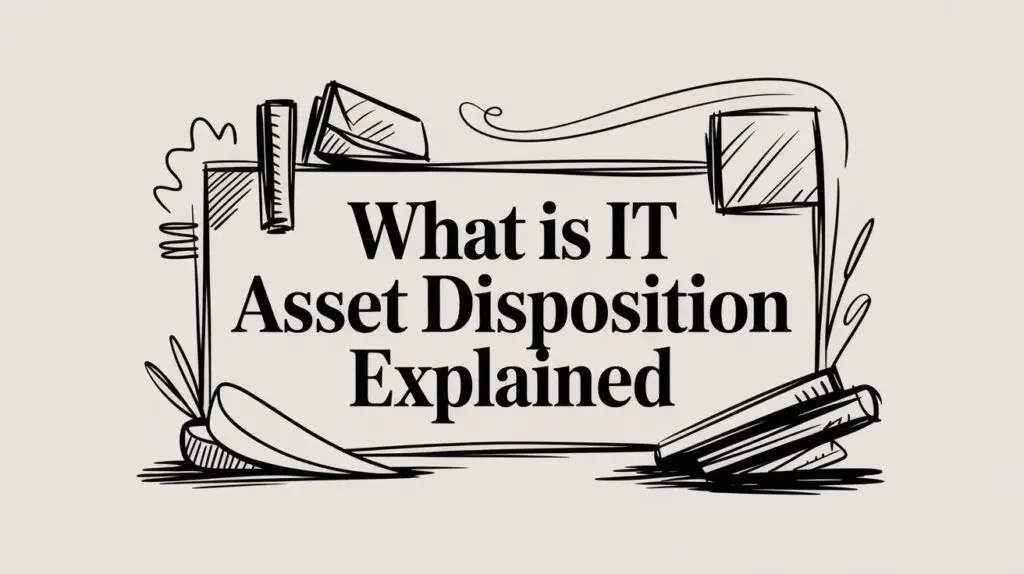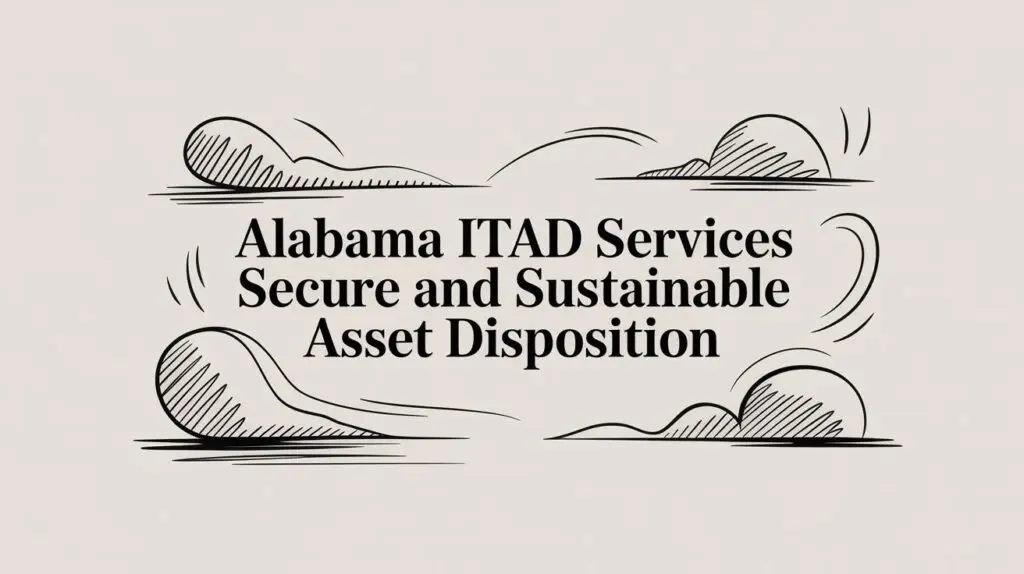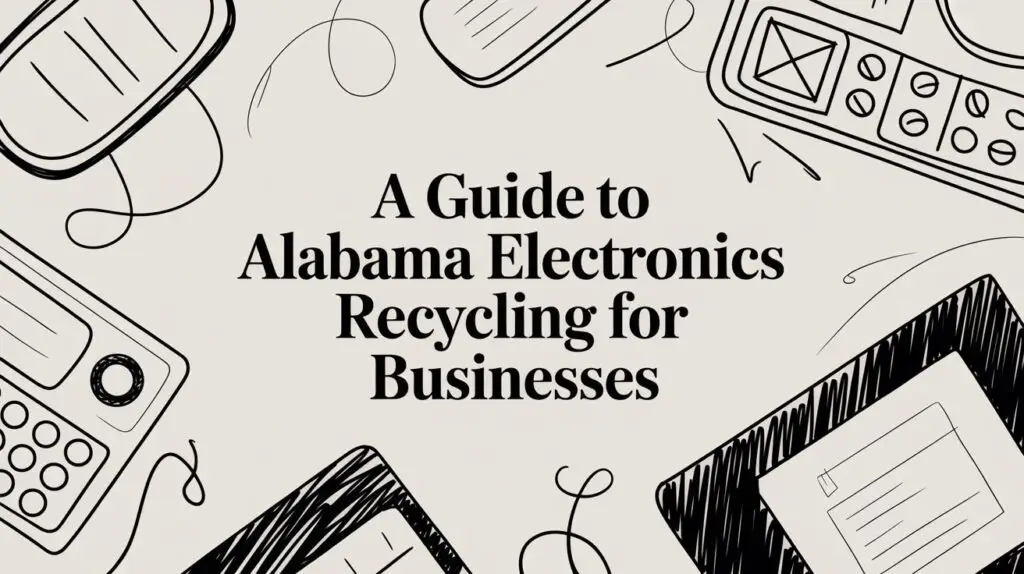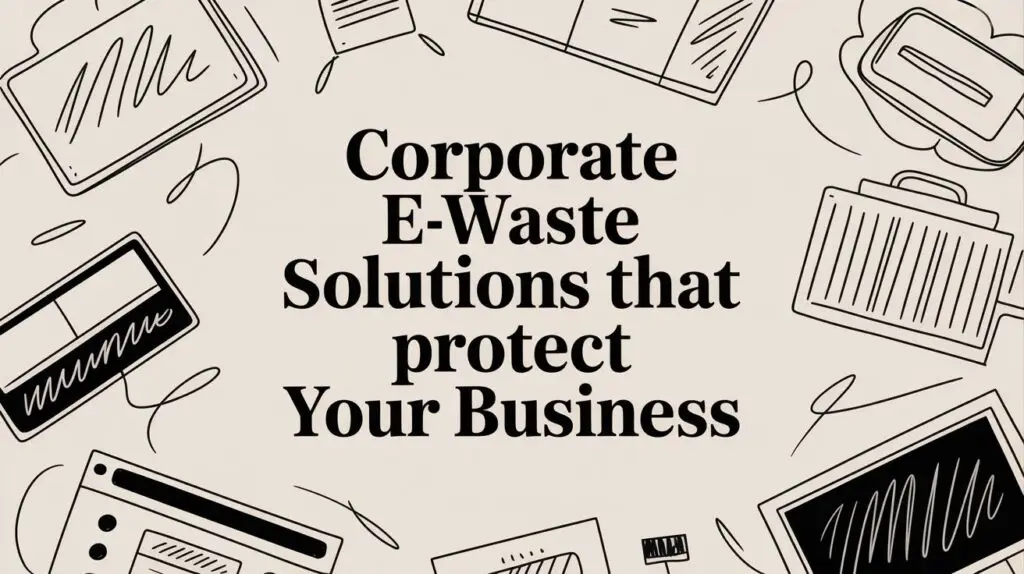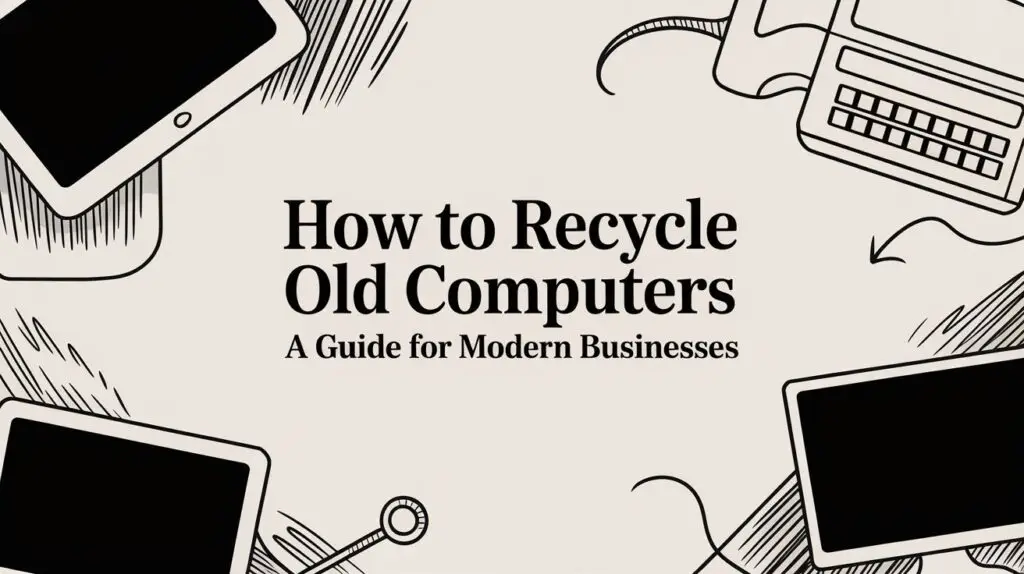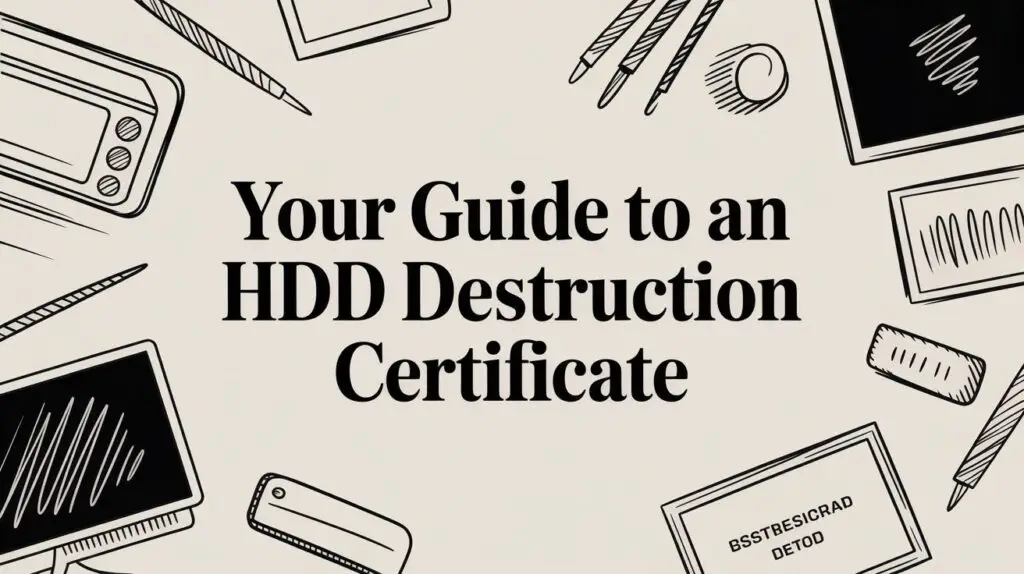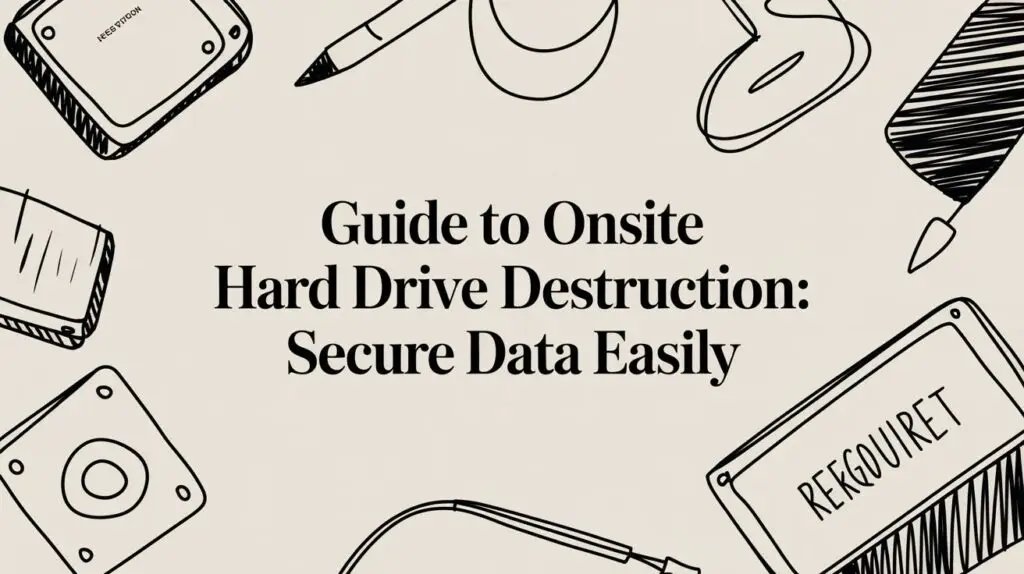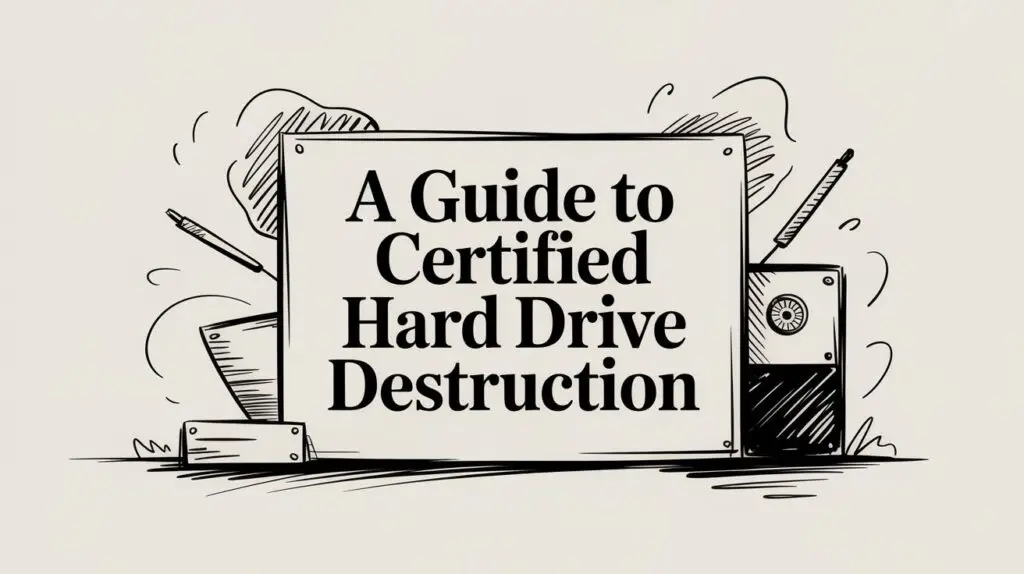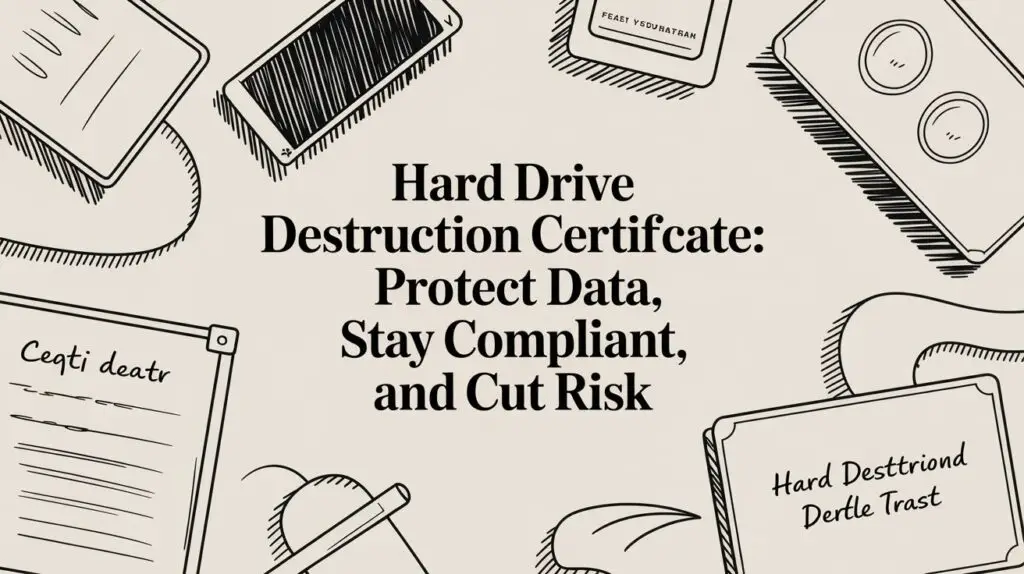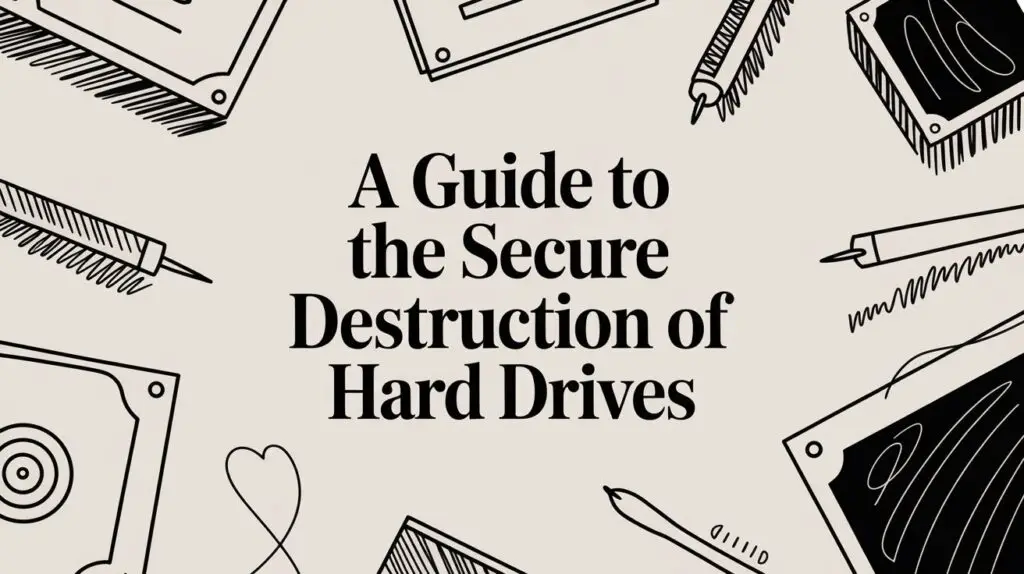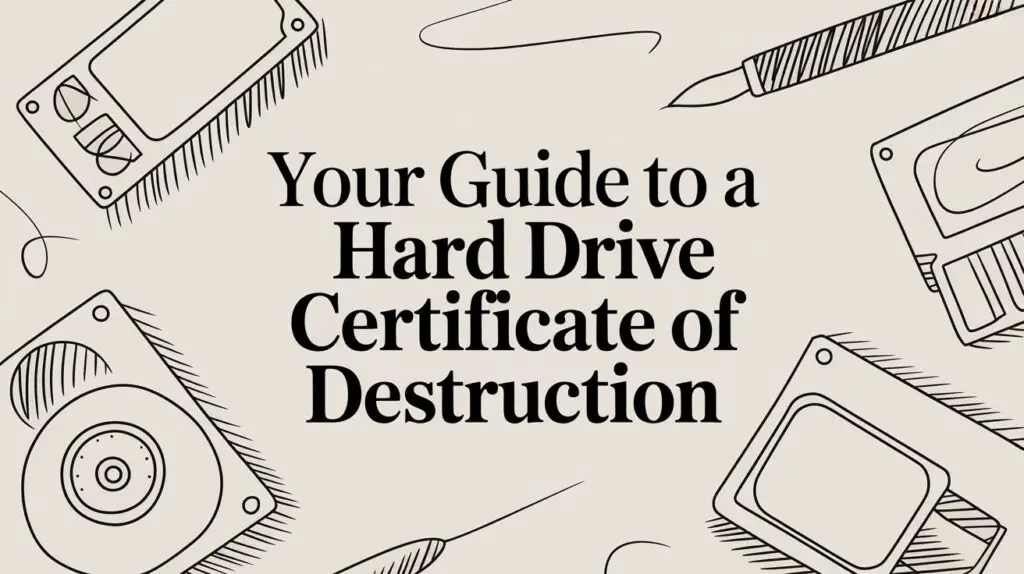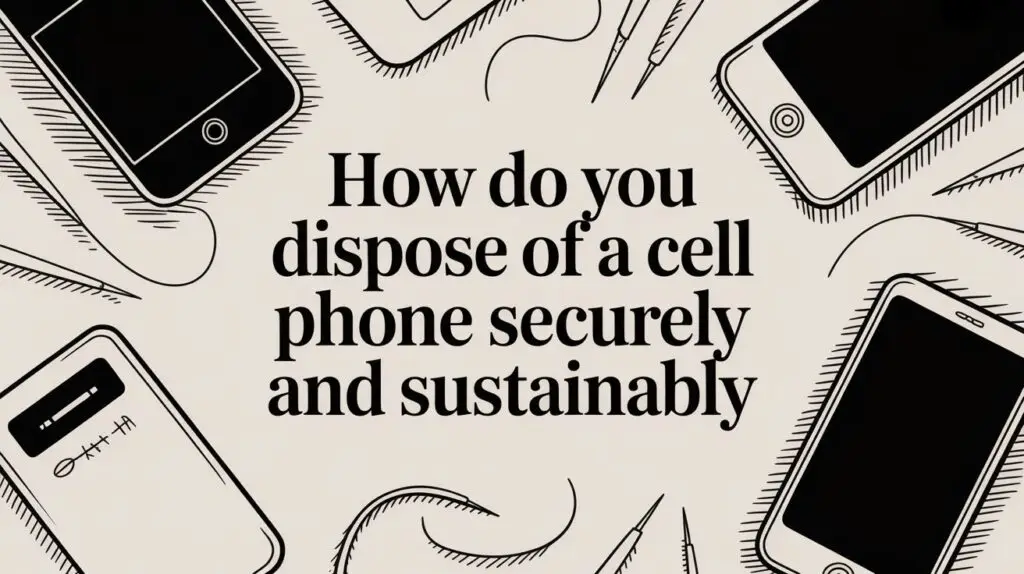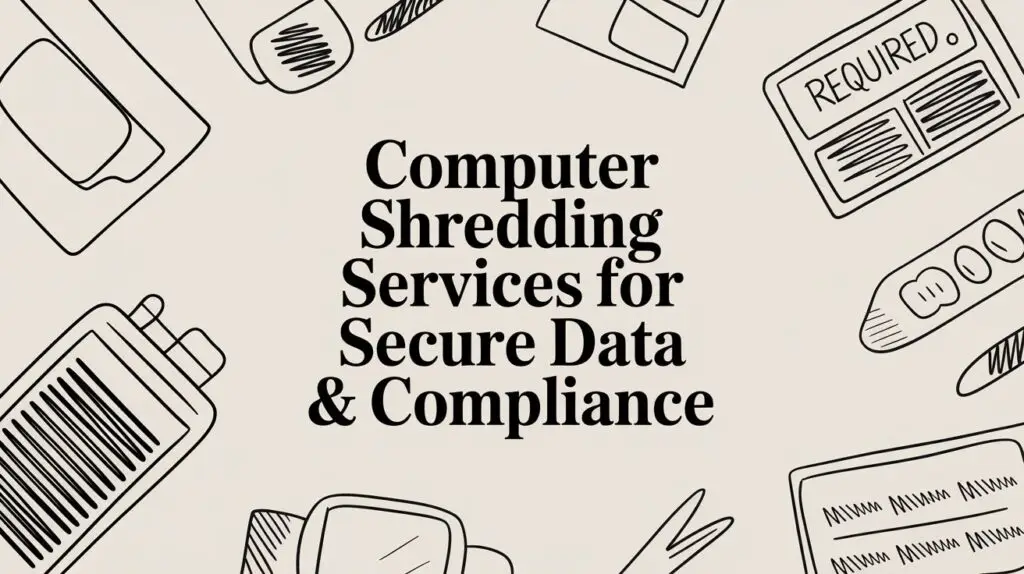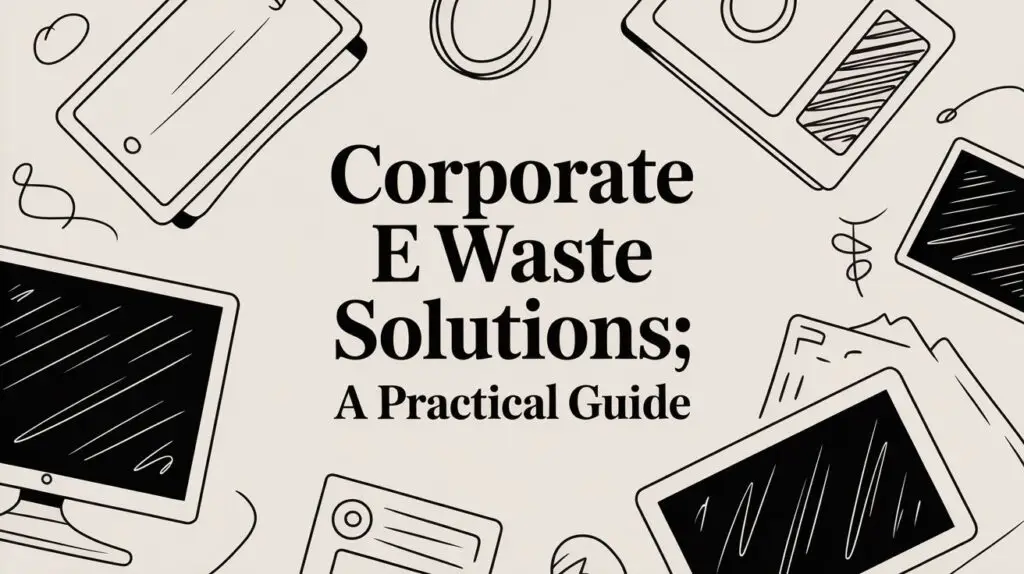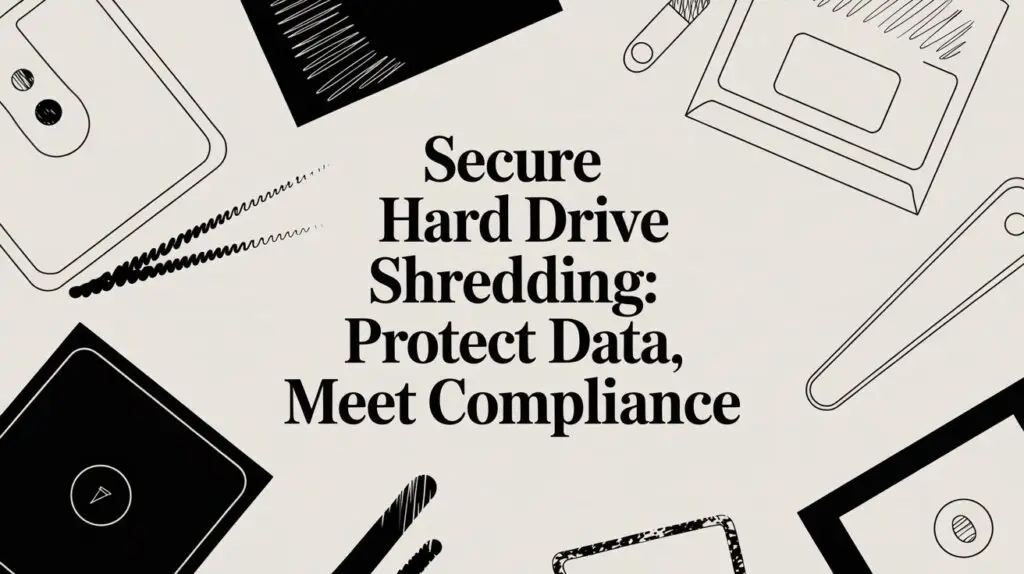So, what is IT Asset Disposition (ITAD), really? It’s the business strategy for responsibly and securely managing IT hardware when it reaches the end of its useful life. This is more than just tossing old gear in a recycling bin. ITAD is a complete lifecycle process for aging computers, servers, and other electronic equipment.
The goal is simple: protect your sensitive business data, comply with all environmental and data privacy regulations, and recover any remaining financial value from obsolete assets.
Your Strategic Playbook for Retiring Technology
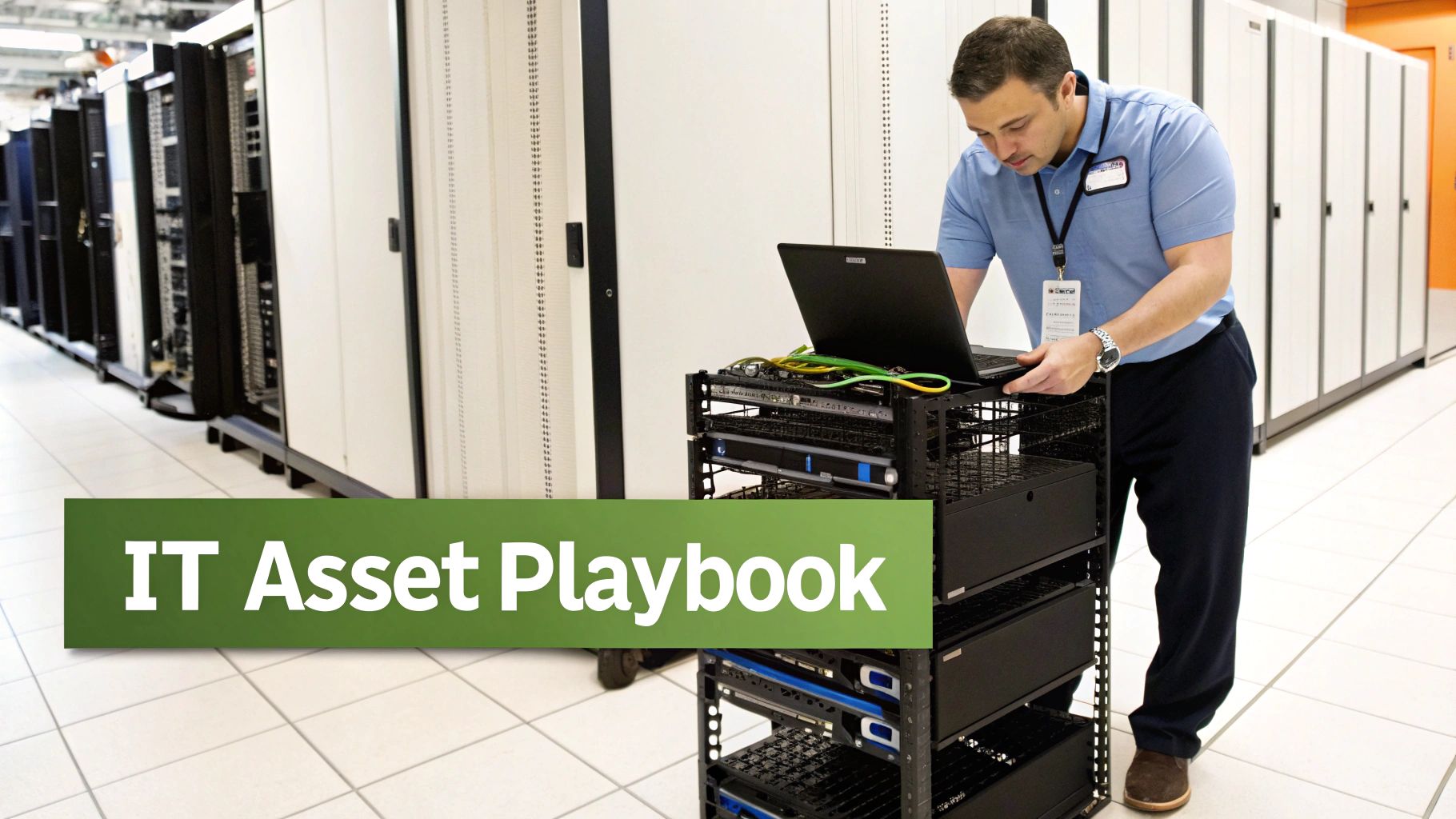
Think of it this way. ITAD is less like a spring cleanout of the office supply closet and more like decommissioning a valuable fleet of company vehicles. You wouldn't just send a truck to a scrapyard without first shredding maintenance logs, salvaging working parts, and ensuring the title is properly transferred.
ITAD applies that same careful, strategic mindset to your technology, from laptop disposal to a full data center decommissioning.
This structured process takes what could be a massive liability—think data breaches, environmental fines, or wasted capital—and transforms it into a predictable, managed business function. It provides every device leaving your facility a documented, secure, and sustainable path forward.
The Four Pillars of Strategic IT Asset Disposition
To truly grasp ITAD, you must understand the four pillars it's built upon. These are the essential components that work in tandem to protect your business and enhance your bottom line. A robust ITAD program balances all four.
Here's a breakdown of how each pillar contributes to a smart ITAD strategy, ensuring nothing is left to chance when your tech assets are retired.
| Pillar | Business Objective | Key Activities |
|---|---|---|
| Data Security | Prevent data breaches and protect sensitive information. | Secure data wiping (DoD 5220.22-M), physical destruction (shredding), degaussing. |
| Regulatory Compliance | Avoid fines and legal penalties. | Adherence to laws like HIPAA, GDPR, FACTA, and environmental regulations like RCRA. |
| Environmental Responsibility | Promote sustainability and avoid e-waste pollution. | Refurbishment, responsible electronics recycling (no-landfill policies), proper handling of hazardous waste. |
| Value Recovery | Maximize financial return on retired assets. | Testing, repairing, and reselling functional equipment through secondary markets. |
This table shows how a comprehensive approach does more than just dispose of old equipment; it actively manages risk, ensures legal adherence, supports green initiatives, and recovers tangible value for your organization.
By integrating these four pillars, IT Asset Disposition stops being a simple disposal task and becomes a key part of your company's risk management, environmental stewardship, and financial optimization strategy.
This is where a social enterprise like Reworx Recycling provides a distinct advantage. As a donation-based recycling partner, Reworx introduces a fifth pillar: community impact. By refurbishing and donating working equipment, your retired assets can help bridge the digital divide for nonprofits and schools. This unique model transforms a standard operational process into a powerful component of your corporate social responsibility program.
To dig deeper into this, you can explore our detailed guide on the importance of IT asset disposition.
Why a Formal ITAD Strategy Is Non-Negotiable
Moving beyond the definition, let’s discuss the risks and rewards that make a formal IT asset disposition program so critical. For any modern business, leaving ITAD to chance isn't just inefficient—it's a high-stakes gamble with your reputation, finances, and legal standing.
An informal or non-existent ITAD plan creates massive blind spots where catastrophic failures can occur. Consider this: a single discarded laptop or old server still containing sensitive customer or employee data can become a devastating liability if it falls into the wrong hands.
The fallout from such an oversight can be crippling, leading to heavy financial penalties and a loss of customer trust that could take years to rebuild.
The High Cost of Inaction
When a company ignores the need for a structured ITAD process, it opens the door to serious vulnerabilities. The most immediate and damaging is the risk of a data breach. A 2020 investigation revealed that nearly 20% of used hard drives sold on the open market still contained personally identifiable information (PII).
These are not just abstract statistics; they represent real threats with severe financial and reputational consequences.
Beyond the breach, there's the tangled web of regulatory compliance. Laws with tough data protection requirements are the norm, and ignorance is not a defense.
- HIPAA (Health Insurance Portability and Accountability Act): This law demands the secure handling of protected health information (PHI), essential for medical equipment disposal. Fines for violations related to improper device disposal can reach millions.
- GDPR (General Data Protection Regulation): Imposes strict rules on the data of EU citizens, with penalties that can go as high as 4% of a company’s global annual revenue.
- FACTA (Fair and Accurate Credit Transactions Act): Requires the proper disposal of consumer information to prevent identity theft.
Failing to comply with these regulations isn't just a slap on the wrist. It can lead to crippling fines, mandatory public disclosures, and long-term damage to your brand's credibility.
Turning Liability Into Opportunity
While risk mitigation is a powerful motivator, a strategic ITAD program offers much more. It’s about reframing retired assets from a burdensome cost center into a potential source of revenue and a powerful tool for corporate social responsibility.
A formal strategy unlocks value that is otherwise lost. Instead of paying someone to haul old equipment away, you can recover a portion of your initial investment.
A well-executed ITAD strategy is not an expense. It's an indispensable part of modern corporate governance, risk management, and environmental stewardship that actively generates value.
This shift in perspective is driving major market growth. Projections show the global ITAD market expanding from around USD 18.7 billion in 2025 to a staggering USD 39.3 billion by 2035, reflecting a compound annual growth rate of 7.7%. This boom is fueled by businesses that see ITAD's strategic importance, and you can discover more insights about these market trends on Future Market Insights.
Partnering with a social enterprise like Reworx Recycling elevates this value proposition. Through our donation-based recycling model, your retired but functional equipment can be securely refurbished and provided to non-profits and schools. This turns a routine disposal process into a meaningful community contribution, strengthening your company's ESG profile and demonstrating a real commitment to social good. For a deeper dive, check out our guide on how to implement an IT asset disposition strategy that aligns with your business goals.
The End-to-End ITAD Process Step by Step
So, what is IT asset disposition in practice? It's best understood as a logical, step-by-step journey for every piece of retired technology. This is not just about disposal; it's a carefully planned sequence designed to protect your organization from start to finish. A professional ITAD strategy provides a clear roadmap for every device that has reached the end of its useful life.
Following this process transforms a potential headache—and a huge liability—into a managed, secure, and fully documented part of your business operations. Each step builds on the previous one, creating a solid chain of custody that is essential for compliance and peace of mind.
This infographic breaks the process down into the three core drivers behind any sound ITAD program: managing risk, ensuring compliance, and recovering value.
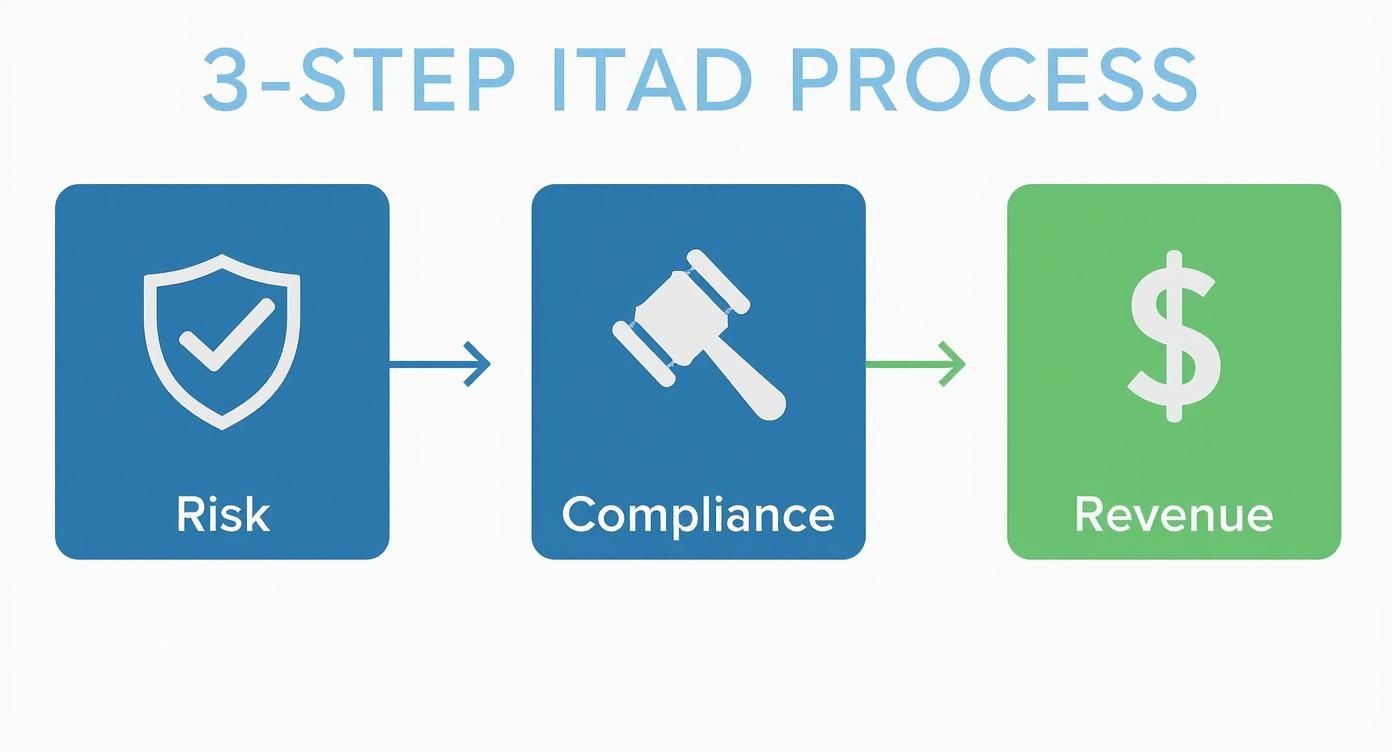
As you can see, a structured approach addresses major security threats first, then handles all legal obligations, and finally focuses on recovering financial value. It’s a smart order of operations.
Asset Inventory and Tracking
Everything begins with meticulous Asset Inventory and Tracking. Before a single server or laptop leaves your building, a detailed inventory must be created. This isn't just a headcount; it means capturing unique identifiers like serial numbers for every asset.
This first step is the foundation of your chain of custody. It creates a verifiable record of what you have, where it is, and its current status. Without it, you cannot prove that every device was handled securely from the moment it left your facility.
Secure Logistics and Transportation
Once inventoried, the next stage is Secure Logistics. This covers the physical collection and transport of your retired hardware. A certified ITAD partner will use secure, GPS-tracked vehicles and trained staff to ensure nothing is lost or stolen en route.
This step is about maintaining the chain of custody you just established. It closes the gap between your facility and the secure processing center, protecting your equipment—and the sensitive data it holds—throughout its journey. To learn more, discover how reverse logistics in IT asset disposition works.
Data Sanitization and Destruction
Now we reach the core of the process: Data Sanitization and Destruction. This is the non-negotiable step where your company’s sensitive information is permanently and irreversibly eliminated. Simply deleting a file does nothing—that data is easily recoverable.
Professional ITAD providers use several methods to guarantee total data security, and they provide documented proof for every single drive.
- Software Wiping: Uses specialized software to overwrite existing data repeatedly, following strict standards like NIST 800-88.
- Degaussing: A powerful magnet scrambles the magnetic field on hard drives, making them completely unreadable.
- Physical Shredding: The ultimate security measure. Hard drives and other storage media are physically shredded into tiny, confetti-like pieces, ideal for product destruction needs.
The method you choose often depends on your internal security policies and data sensitivity. For absolute, ironclad assurance, many organizations opt for physical shredding.
Triage for Remarketing or Recycling
After every bit of data has been destroyed, the assets are triaged. This sorting process determines the best path for each piece of equipment based on its age, condition, and functionality. It’s where value recovery meets environmental responsibility.
Assets with remaining market value are tested, graded, and refurbished for resale. This remarketing process can generate significant revenue, turning a cost center into an income source. Equipment that is too old or broken for reuse moves to the final stage.
Beyond remarketing, sustainable recycling is a vital part of ITAD. This ensures everything is handled ethically and in line with environmental laws. Components are broken down into raw materials—plastics, metals, glass—which are then recycled to make new products. A true no-landfill policy is the cornerstone of any sustainable ITAD program.
Comprehensive Reporting and Certification
The final step is Comprehensive Reporting and Certification. A professional ITAD partner will provide detailed documentation that closes the loop on the entire process. This isn’t a simple receipt; it’s your auditable proof that everything was done by the book.
This reporting packet should always include:
- A full inventory reconciliation, showing that the final outcome of every asset matches the initial list.
- A Certificate of Data Destruction, listing the serial numbers of the sanitized devices and the method used.
- A Certificate of Recycling, confirming that any non-reusable materials were handled in an environmentally sound manner.
This paperwork is your shield. It protects you from regulatory fines and serves as proof that you took every necessary step to protect sensitive information, validating the entire process from start to finish.
Choosing the Right ITAD Partner
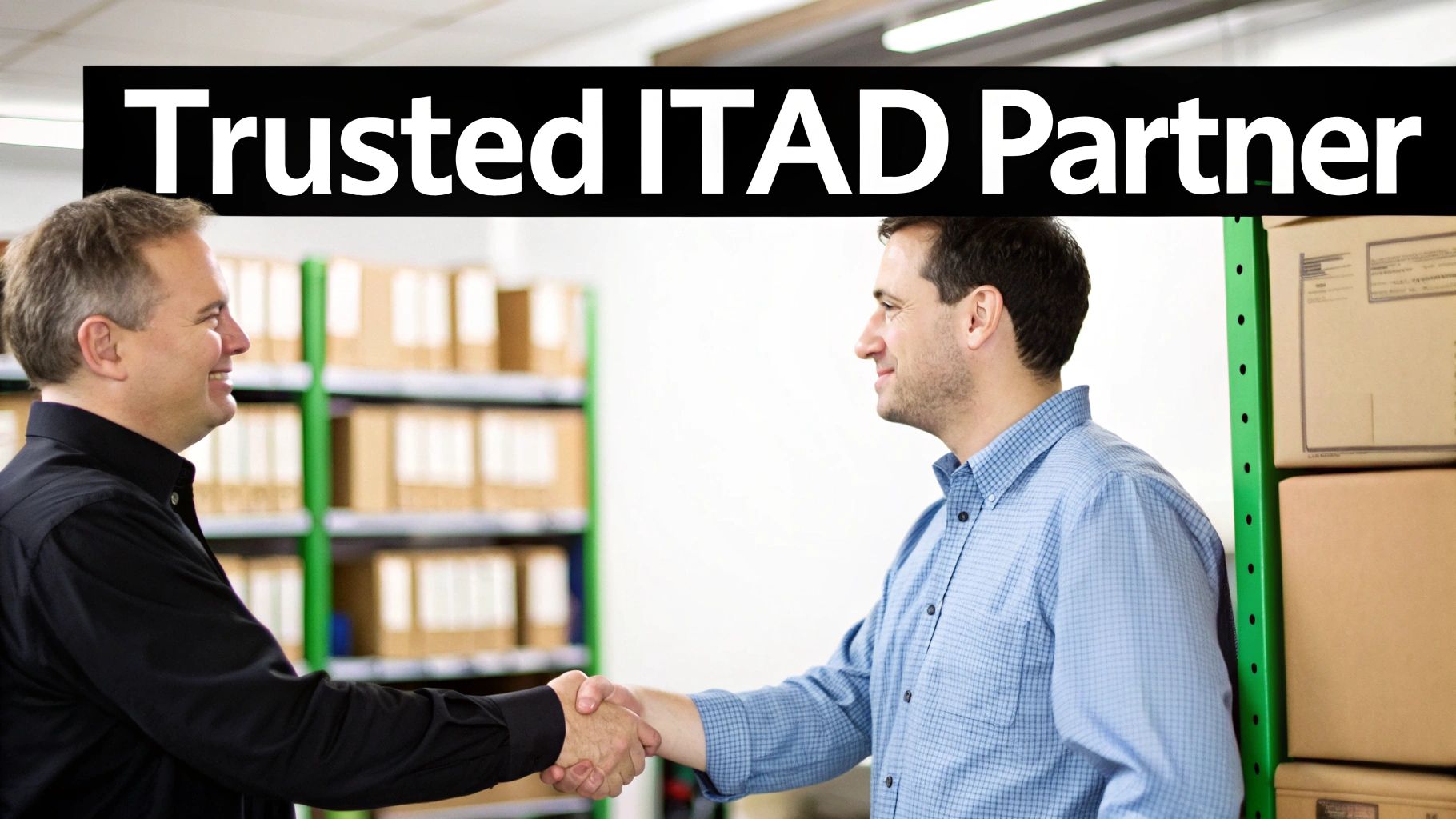
Selecting an IT asset disposition vendor is a critical decision in your technology lifecycle management. This isn’t just another transaction. You're entrusting a partner with your sensitive data, legal compliance duties, and brand reputation. It's crucial to look beyond the price tag and find a partner who delivers genuine security, transparency, and total accountability.
The right partner becomes an extension of your risk management and compliance teams. They bring the expertise, infrastructure, and certifications needed to navigate the complex worlds of data security and environmental law. A poor choice can expose your organization to devastating data breaches, crippling fines, and lasting reputational damage.
Look for Verifiable Certifications
When vetting potential ITAD providers, certifications are your first line of defense. These aren't just logos for a website; they are hard-earned proof that a vendor has passed rigorous, third-party audits of their security, processes, and environmental practices. Think of them as the industry's seal of approval.
Here are the key certifications to look for and what they mean for your business:
- R2 (Responsible Recycling): This certification ensures the provider adheres to best practices for electronics recycling. It covers environmental protection, worker health and safety, and data security, guaranteeing your old tech won't end up in a landfill.
- e-Stewards: Often considered one of the toughest environmental standards, e-Stewards certification strictly prohibits exporting hazardous e-waste to developing nations and demands the highest level of responsible recycling.
- NAID AAA: This certification is all about secure data destruction. A vendor with NAID AAA certification has proven their methods for destroying data on hard drives and other media are secure, compliant, and consistently verified.
These credentials offer a baseline of trust and demonstrate a vendor’s commitment to doing things the right way. They are non-negotiable for any organization serious about protecting its assets.
Scrutinize Data Destruction Capabilities
Certifications are an excellent start, but you also need to examine a vendor’s specific methods for data destruction. A top-tier partner will offer multiple sanitization options and follow globally recognized standards like NIST 800-88. This framework from the National Institute of Standards and Technology provides clear guidelines for everything from software-based wiping to physical shredding.
Your potential partner must be able to transparently explain their procedures and provide audit-proof documentation for every device they handle. This includes a serialized Certificate of Data Destruction, which serves as your legal proof that the data is gone for good.
A key question to ask any potential vendor is: "Can you provide a complete, unbroken chain of custody from the moment my assets leave my facility until I receive the final destruction certificate?" The answer should be an unequivocal "yes," backed by detailed tracking and reporting systems.
The table below breaks down the key differences between a certified ITAD partner and a standard recycler.
Comparing Certified ITAD Partners vs. Standard Recyclers
| Feature | Certified ITAD Partner (e.g., Reworx Recycling) | Standard Recycler |
|---|---|---|
| Data Security | Follows NIST 800-88 standards; NAID AAA certified data destruction with serialized reporting. | Basic data wiping, often without certification or detailed audit trails. |
| Compliance | R2 and/or e-Stewards certified, ensuring adherence to environmental and data privacy laws (HIPAA, GDPR). | May not hold key certifications, posing compliance risks. |
| Chain of Custody | Secure, GPS-tracked logistics with documented chain of custody from pickup to final disposition. | Limited tracking; chain of custody may be broken or undocumented. |
| Value Recovery | Focus on maximizing ROI through remarketing and component harvesting. | Primarily focused on scrap material value; less emphasis on refurbishment. |
| Reporting | Provides detailed, asset-level reports, including certificates of data destruction and environmental impact statements. | Basic reports, often just weight-based summaries without individual asset details. |
| Environmental Impact | Guarantees responsible recycling and prohibits illegal e-waste exports. | May export hazardous materials to developing countries; lacks oversight. |
As you can see, the level of security, accountability, and value a certified partner provides is in a completely different league.
The Social Enterprise Advantage
Finally, don't overlook the unique value that a social enterprise like Reworx Recycling brings to the partnership. A traditional ITAD vendor focuses purely on the transactional side of security and value recovery. A mission-driven partner adds a powerful layer of community impact and corporate social responsibility (CSR).
When you choose a donation-based partner like Reworx Recycling, your company’s retired but still-useful equipment can be securely refurbished and given to nonprofits, schools, and community programs. This simple choice transforms a standard operational task into a tangible way to help bridge the digital divide. It amplifies your company's ESG (Environmental, Social, and Governance) goals, turning your ITAD program into a positive story you can share with stakeholders, customers, and employees through corporate donation programs.
Making Sense of ITAD Costs and ROI
Many businesses mistakenly view IT asset disposition as just another expense on the balance sheet—a necessary chore. But that’s a shortsighted perspective. A strategic approach changes the entire financial picture, transforming ITAD from a cost center into a powerful source of return on investment (ROI).
Sure, services like secure logistics, certified data destruction, and detailed reporting come with fees. Consider these as investments in risk mitigation. The real story isn't about what ITAD costs, but what happens when you lack a solid process.
The Real Price of Doing Nothing
The biggest financial hits don't come from service fees—they come from disaster. An old hard drive tossed in a dumpster can easily lead to a data breach. Once you tally the fines, legal fees, and reputational damage, the average cost skyrockets into the millions.
And it’s not just about data. Ignoring environmental rules can also result in painful penalties. The true cost of inaction is a massive, lurking liability that makes the predictable expense of a professional ITAD program seem minor in comparison.
Where Does the ROI Come From?
A smart ITAD strategy doesn't just prevent loss; it actively generates value. The most direct return comes from asset remarketing. That old server, laptop, or networking switch might be obsolete to you, but it often holds real value on the secondary market. A good ITAD partner can test, repair, and resell it, turning retired hardware into a direct revenue stream.
Beyond big-ticket items, you can find other ways to recoup value. For instance, many companies overlook simple opportunities like selling unused toner cartridges for value recovery.
But the indirect ROI is where the value truly multiplies:
- Risk Aversion: The best return is the money you don’t lose. The cost of your entire ITAD program can be justified for years by avoiding just one data breach or compliance fine.
- Operational Efficiency: Consider the space and staff time tied up in managing old equipment. Freeing up these resources provides a tangible boost to productivity.
- Stronger Brand: When you demonstrate a real commitment to data security and sustainability, stakeholders notice. It strengthens your reputation, helping to attract both customers and top talent.
The global ITAD market is heavily shaped by the challenge of e-waste, especially from data centers. In 2024, the data center segment comprised over 60% of the global ITAD market, driven largely by strict environmental regulations for handling e-waste in major hubs across the U.S. and other countries.
The Social Enterprise Multiplier
When you partner with a social enterprise recycling firm like Reworx Recycling, you add another powerful layer of value. Our donation-based model means your retired but still-working equipment can be securely refurbished and given a new life with non-profits and schools.
This approach elevates your ITAD program from a simple operational task to a core part of your company’s ESG (Environmental, Social, and Governance) efforts. The positive impact you make in the community becomes a real, measurable part of your ROI, boosting your corporate citizenship and brand loyalty.
It’s the perfect way to turn a compliance task into an opportunity that benefits your finances, your brand, and your community. To get a closer look at how this works, check out our guide on maximizing value through IT asset disposition.
Common ITAD Mistakes and How to Avoid Them
Even with the best intentions, companies can make costly missteps when their IT assets reach retirement. Navigating IT asset disposition isn't something to be improvised—it requires careful planning to sidestep common pitfalls that lead to data breaches, compliance failures, and lost revenue.
The most common error is focusing solely on the lowest price. Choosing an ITAD vendor based on cost alone is a dangerous gamble. Uncertified, low-cost operators often cut corners on critical steps like data destruction and environmental compliance, leaving your business exposed to massive security and legal risks.
Neglecting Internal Policies and Chain of Custody
Another significant mistake is the lack of a clear internal policy for retiring assets. Without standardized procedures for an office cleanout or facility cleanout, employees may resort to what seems easiest, like storing old laptops in a forgotten closet or calling a random local recycler. This breakdown in process creates serious security gaps and makes tracking impossible.
This leads directly to a failure to maintain a complete chain of custody. A documented, unbroken chain of custody from the moment an asset leaves your control is your single best defense in an audit. Without it, you cannot prove every device was handled securely and its data was properly destroyed.
To get this right, your organization should:
- Develop a formal ITAD policy: Clearly outline the steps for retiring any company device. Specify who is responsible and which certified partners to use.
- Demand serialized reporting: Insist on detailed reports from your ITAD partner that track each asset by its unique serial number from pickup to final disposition.
- Partner with certified vendors: Work exclusively with providers holding certifications like R2v3 or NAID AAA. This is your guarantee that their processes are regularly audited and secure.
Prematurely Recycling Valuable Assets
A third critical error is sending equipment for recycling when it still holds significant resale value. Many standard recyclers are built for material recovery. They might shred perfectly good servers, laptops, and networking gear that could have been refurbished and sold, putting cash back into your IT budget.
This rush to recycle misses out on a key benefit of a strategic ITAD program. The global IT asset disposition market is projected to skyrocket to USD 90.06 billion by 2034, as businesses get smarter about recovering value from their old tech. You can discover more about this market growth on Precedence Research.
The solution is to work with a vendor that prioritizes remarketing first. A partner like Reworx Recycling assesses all incoming equipment for its reuse potential from the get-go. By securely refurbishing and remarketing valuable assets, we help you maximize your financial return before responsibly recycling anything that's left.
Got Questions About ITAD? We’ve Got Answers.
When it comes to disposing of old technology, IT managers and business leaders often have the same practical questions. Let's clarify some of the most common ones with direct, no-nonsense answers that reinforce what a secure and responsible process looks like.
ITAD vs. Electronics Recycling
What’s the real difference between ITAD and just recycling electronics?
It’s easy to confuse them, but they are fundamentally different. Basic electronics recycling focuses on one thing: breaking down old devices to recover raw materials. Think of it as the final stop for hardware.
In contrast, ITAD is a complete, strategic business process. It’s not just about disposal; it’s about managing every step of a tech asset’s retirement. This includes secure data destruction, ensuring regulatory compliance, and recovering value by refurbishing and reselling equipment. ITAD is a comprehensive approach that protects your business from risks that simple recycling doesn't address.
Verifying Data Destruction
How can I be absolutely sure my company’s data is gone for good?
You need auditable proof. That's why a certified ITAD partner like Reworx Recycling always provides a formal Certificate of Data Destruction upon completion.
This isn't just a piece of paper; it's your official compliance record. It details exactly how the data was sanitized—whether through software wiping, degaussing, or physical shredding—and lists the serial numbers of every device processed. It creates a clear, auditable trail that proves due diligence.
ITAD for Small Businesses
Is a formal ITAD program really necessary for a small business?
Absolutely. Data security laws like HIPAA don't only apply to large corporations. The financial and reputational damage from a data breach can be even more devastating for a small business.
Professional ITAD services are scalable, meaning small and medium-sized businesses (SMBs) can achieve the same level of risk management as large enterprises. Working with an expert ensures that even a handful of retired laptops are handled securely. Furthermore, SMBs are often surprised by the value they can recover from equipment they thought was worthless.
The Reworx Recycling Donation Process
What actually happens to the equipment we donate through Reworx Recycling?
When you partner with our social enterprise, your donated equipment is given a new mission. After every device undergoes our strict, certified data destruction process, our technical team carefully refurbishes anything that is still viable.
These refreshed computers and laptops are then provided to non-profits, local schools, and community programs to support digital inclusion and workforce development. It's a direct way to help bridge the digital divide in our community. By choosing to donate, you transform old technology from a potential liability into a genuine force for good—a perfect fit for your corporate social responsibility goals.
Ready to turn your retired IT assets into a secure, sustainable, and socially responsible solution? Partner with Reworx Recycling to protect your data, support your community, and ensure environmental compliance. Schedule a pickup or learn more about our corporate donation programs today. Explore our services at https://www.reworxrecycling.org/category/recycling-blog.

